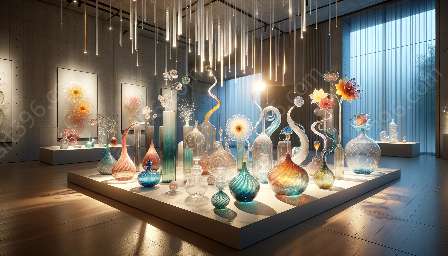Glass art has been a popular and versatile medium for interior design for centuries. Its shimmering beauty and capacity to refract light have made it a favorite among designers and homeowners alike. However, in our modern age of environmental consciousness, it's important to consider the ecological impact of utilizing glass art in interior design.
Impact on Sustainability
One of the primary environmental considerations when using glass art in interior design is the impact on sustainability. The production of glass typically involves the extraction of raw materials such as sand, soda ash, and limestone, as well as high-temperature energy-intensive processes. These processes can have a significant carbon footprint and can contribute to environmental degradation if not managed properly.
However, the environmental impact of glass art can be mitigated through the use of recycled glass. Repurposing glass from previous products reduces the demand for new raw materials and helps to conserve energy and reduce waste.
Energy Efficiency
Another aspect to consider is the energy efficiency of using glass art in interior design. Glass is known for its ability to transmit light effectively, reducing the need for artificial lighting during the day. By allowing natural light to penetrate a space, the use of glass art can contribute to energy savings and a lower carbon footprint.
Furthermore, advances in glass technology, such as the development of low-emissivity (Low-E) coatings, have made it possible to enhance the energy efficiency of glass products by reducing heat transfer and improving insulation.
Recyclability and Longevity
When evaluating the environmental impact of glass art in interior design, recyclability and longevity are crucial factors. Glass is 100% recyclable, meaning it can be indefinitely reprocessed without loss of quality. This promotes a closed-loop system and reduces the accumulation of glass waste in landfills.
Additionally, glass art, when properly cared for, can have a long lifespan. Investing in high-quality, durable glass art pieces can contribute to sustainable practices by minimizing the need for frequent replacements and reducing overall material consumption.
Environmental Considerations in Glass Art Production
It's also essential to consider the eco-friendliness of the production processes involved in creating glass art. Opting for manufacturers that prioritize sustainable sourcing of raw materials, minimize water and energy usage, and implement responsible waste management practices can make a significant difference in reducing the ecological footprint of glass art.
Integration with Eco-Friendly Design Practices
Finally, incorporating glass art into interior design should align with broader eco-friendly design practices. Pairing glass art with sustainable materials, such as reclaimed wood, bamboo, or recycled metals, can create a harmonious and environmentally conscious aesthetic that promotes sustainability throughout the design space.
Influence of Glass Art in Interior Design
Enhancing Aesthetics and Ambiance
Glass art has a profound influence on interior design by enhancing the aesthetics and ambiance of a space. Its reflective properties can create the illusion of spaciousness and light, making it a valuable tool for interior designers seeking to elevate the visual appeal of a room.
Expression of Creativity and Individuality
Through the use of glass art, interior design can become a medium for expressing creativity and individuality. Glass art pieces, whether they are sculptures, installations, or functional elements, can serve as focal points that reflect the unique style and personality of the space's inhabitants.
Integration of Nature and Light
Glass art has the power to seamlessly integrate nature and light into interior spaces. By harnessing natural light and incorporating organic forms and textures, glass art can bring the essence of the outdoors inside, fostering a connection to nature within the built environment.
Artistic Versatility and Adaptability
The versatility and adaptability of glass art allow it to complement a wide range of design styles and themes. Whether the design calls for minimalist elegance or bold, statement-making pieces, glass art can be tailored to suit diverse aesthetic preferences and architectural contexts.
Glass Art
History and Cultural Significance
Glass art has a rich history and cultural significance that permeates various civilizations and periods. Dating back to ancient civilizations such as the Mesopotamians and Egyptians, glass art has been cherished for its beauty and utility, symbolizing craftsmanship, luxury, and artistic expression.
Technical Mastery and Innovation
The evolution of glass art has been marked by technical mastery and innovation. From the invention of glassblowing techniques to the exploration of new forms and applications, glass art continues to push the boundaries of artistic expression and material manipulation.
Contemporary Trends and Influences
In the contemporary art and design landscape, glass art remains a compelling medium that is continuously evolving. Influenced by advancements in technology, sustainability considerations, and global design trends, contemporary glass art reflects the fusion of tradition and innovation.
In conclusion, the incorporation of glass art into interior design necessitates thoughtful consideration of its environmental impact, from sustainable production practices to energy efficiency and recyclability. By understanding the environmental considerations related to glass art, designers and homeowners can make informed choices that align with principles of eco-friendliness and contribute to a more sustainable built environment.

